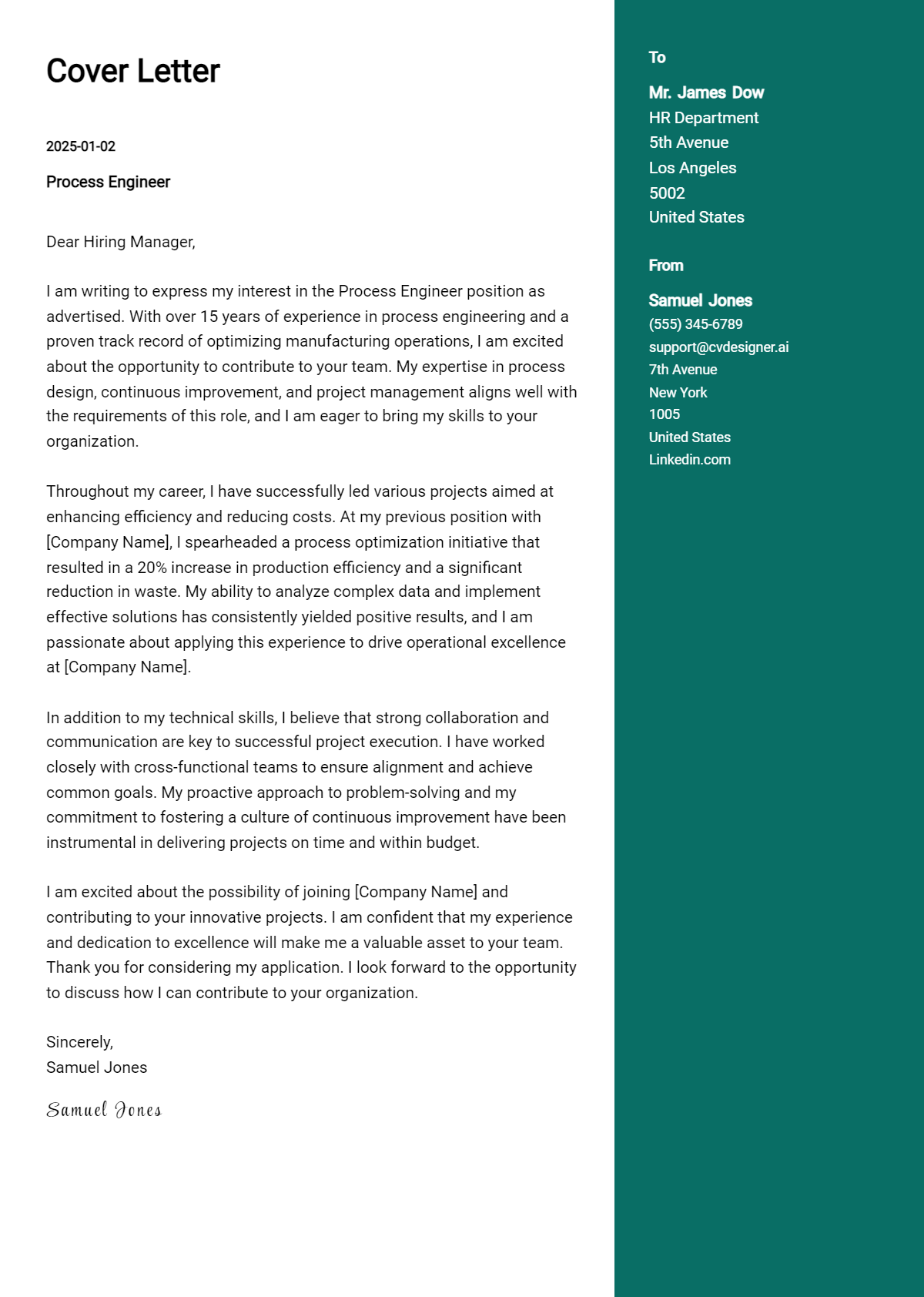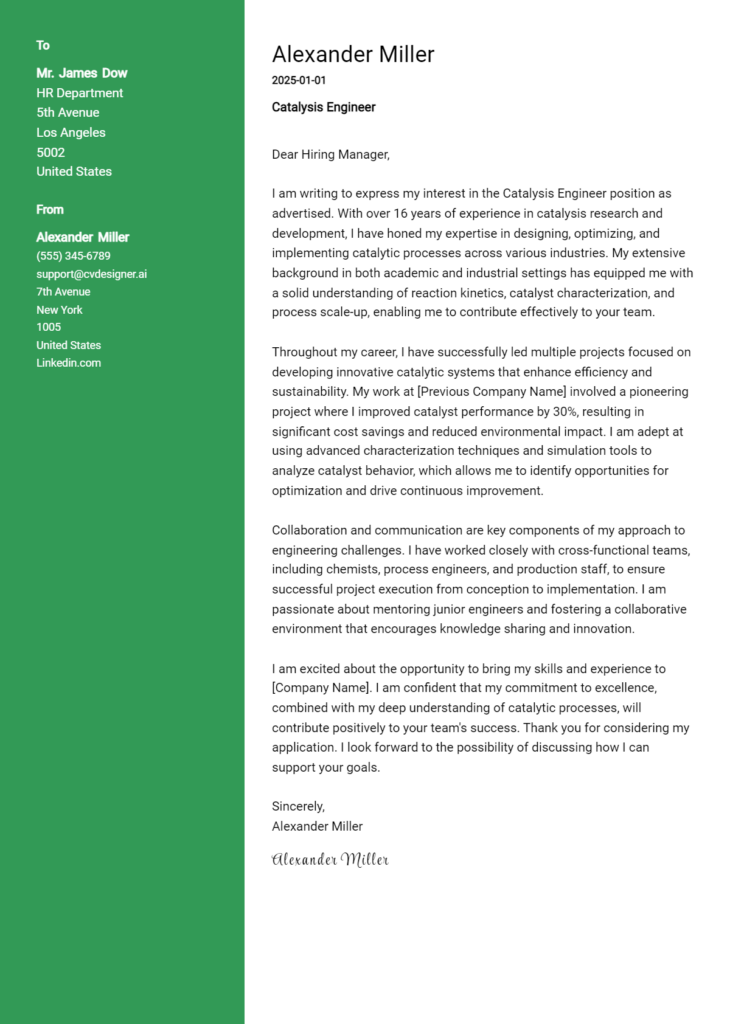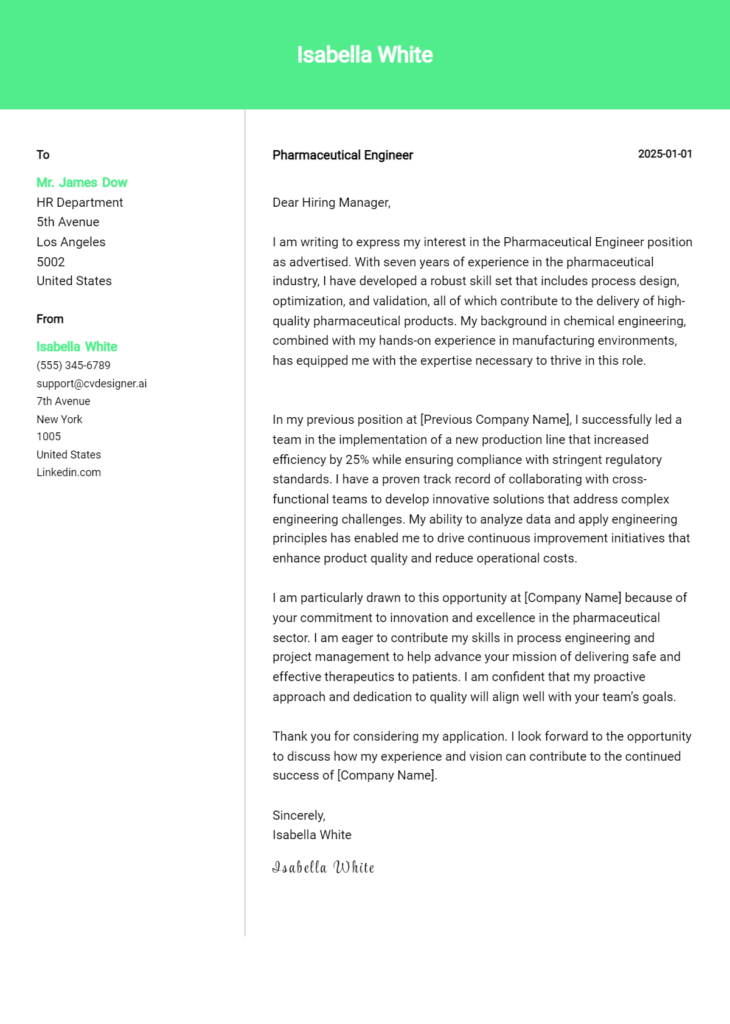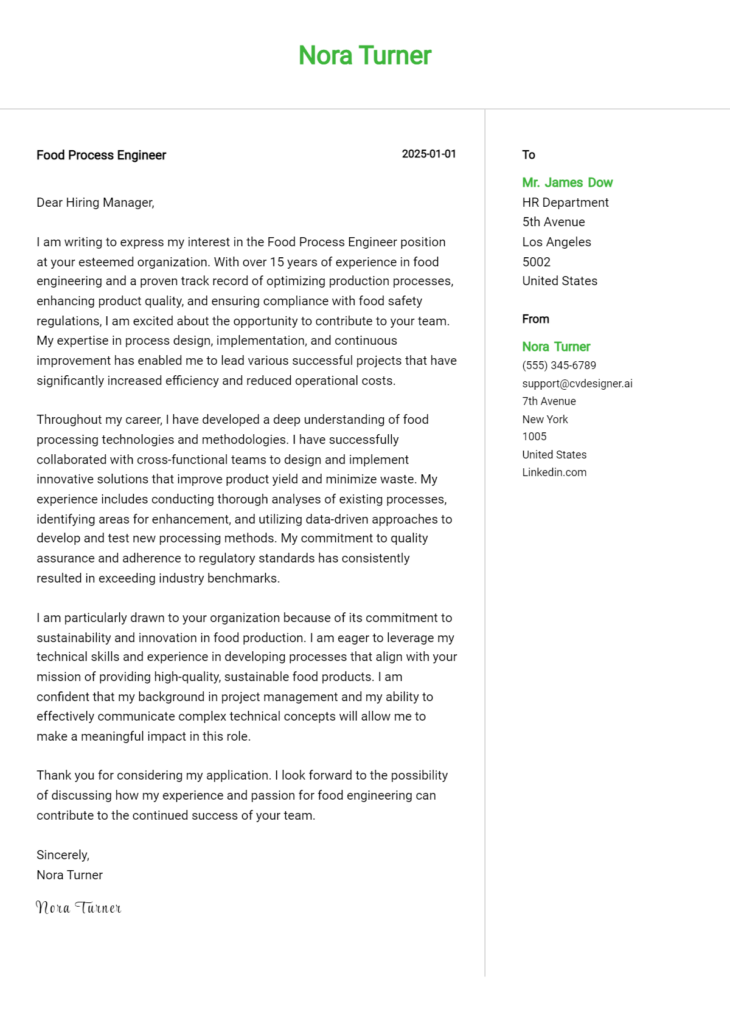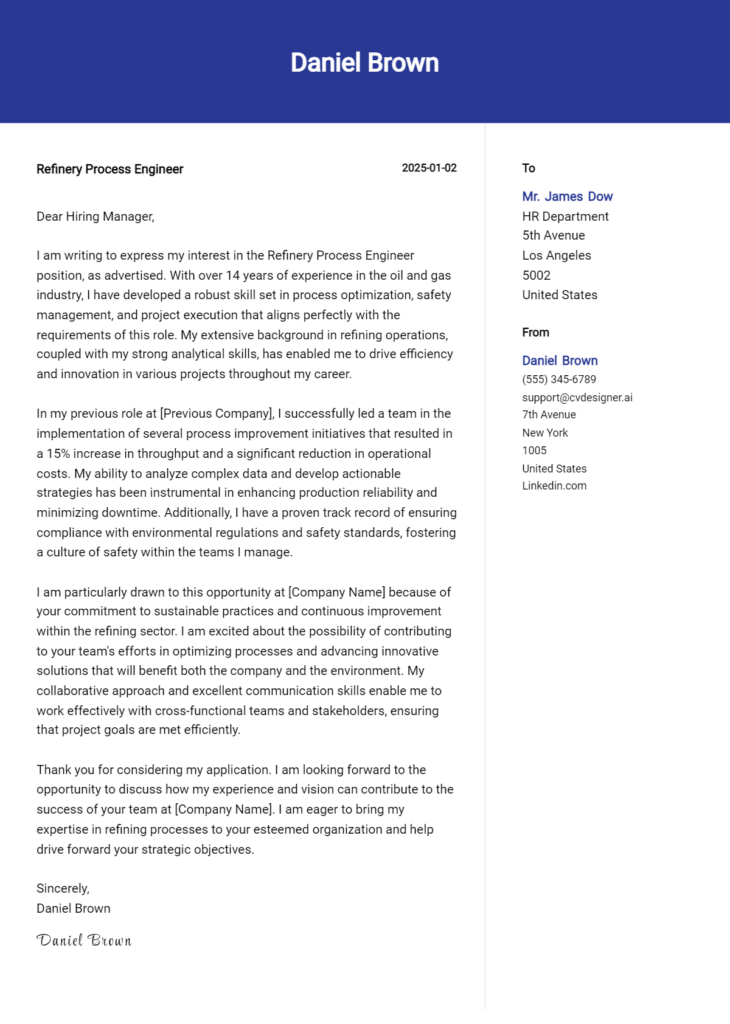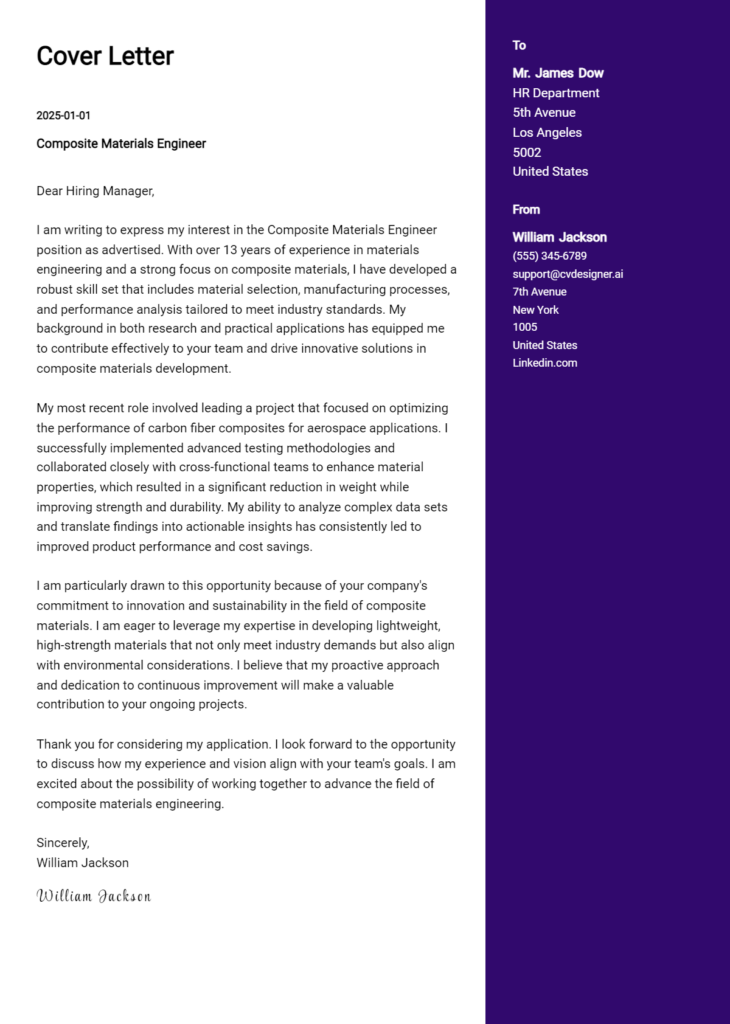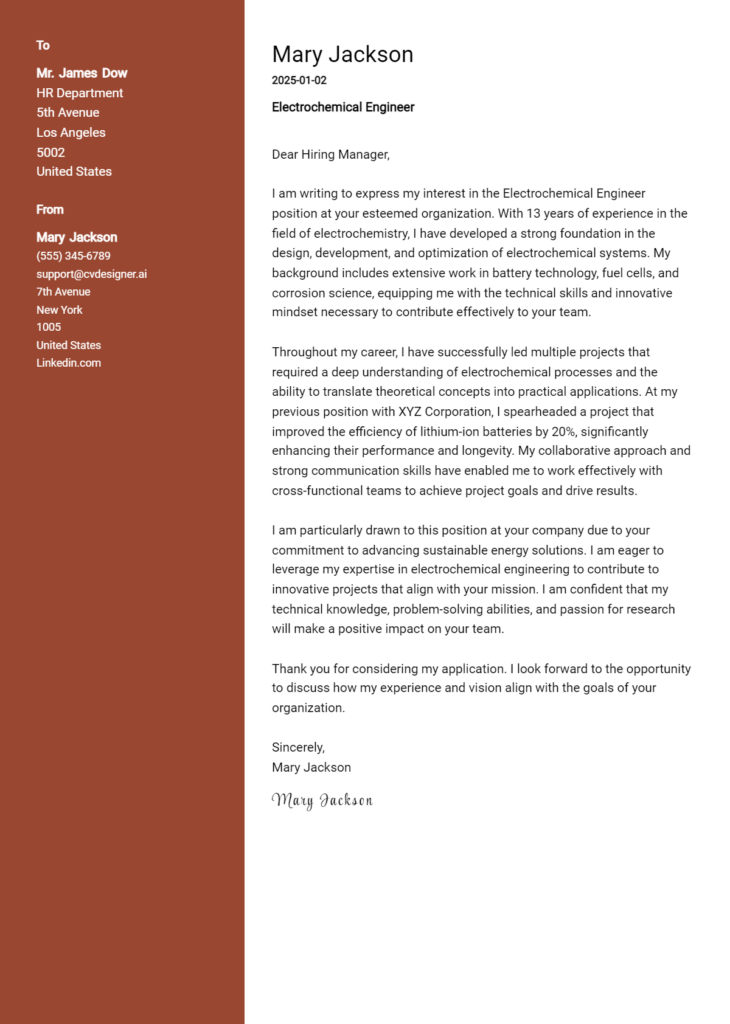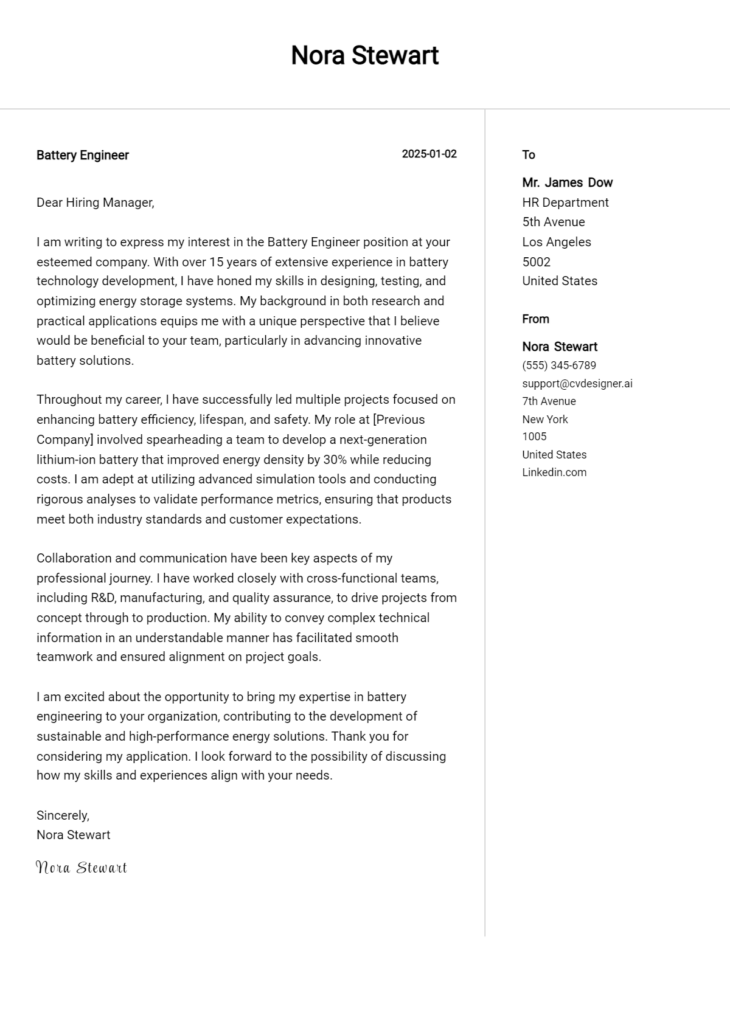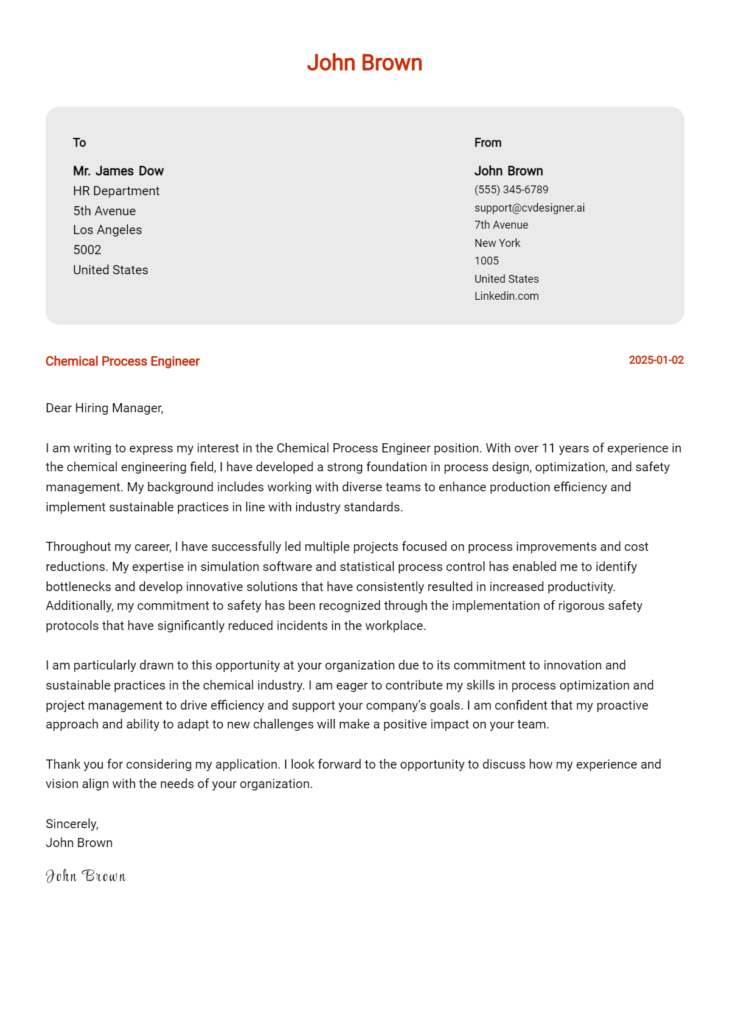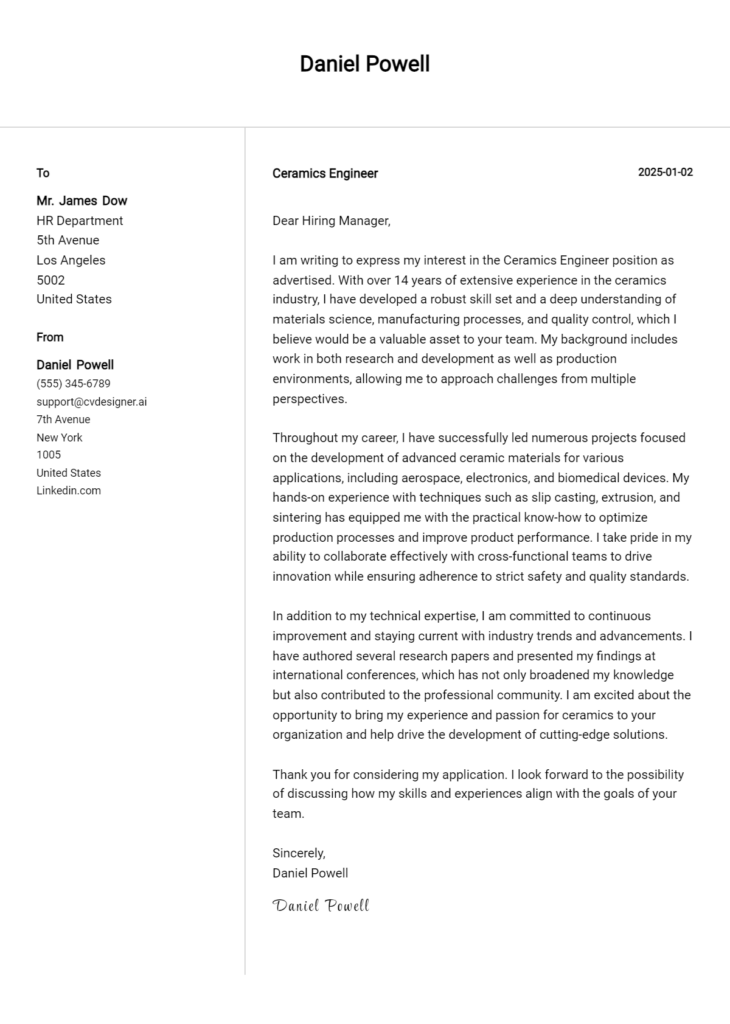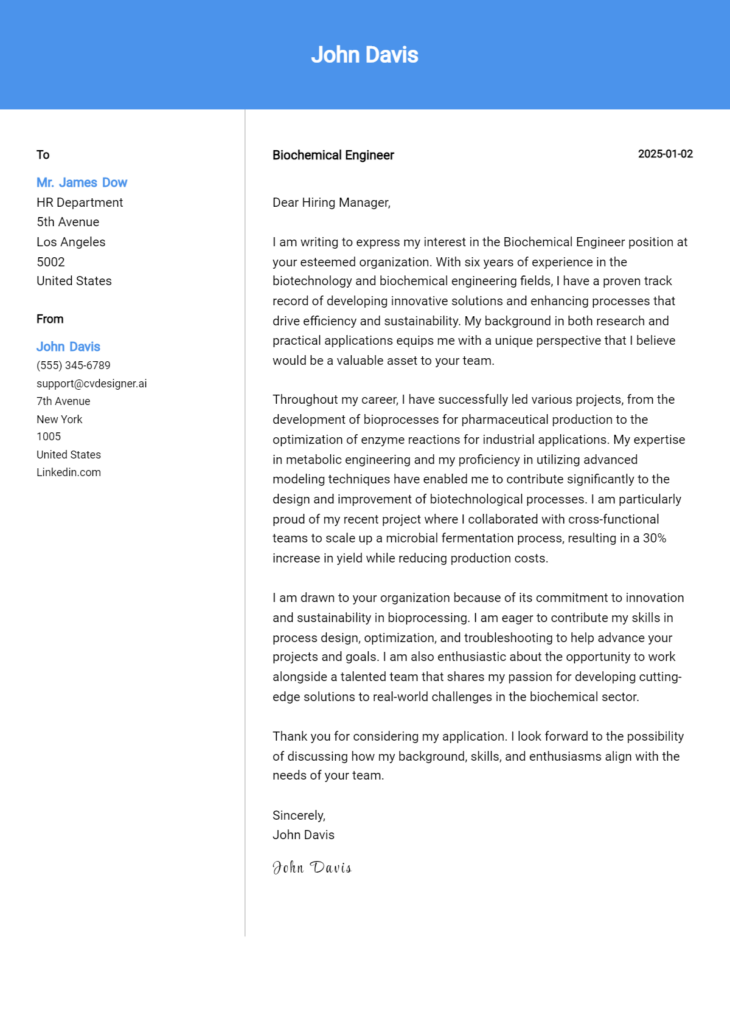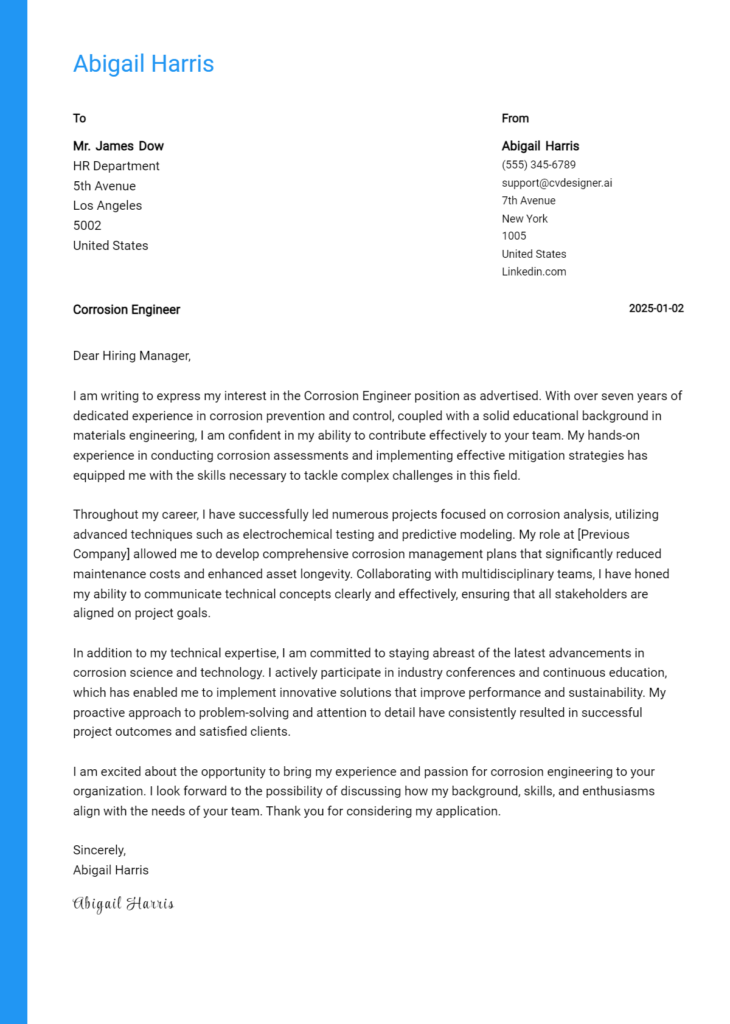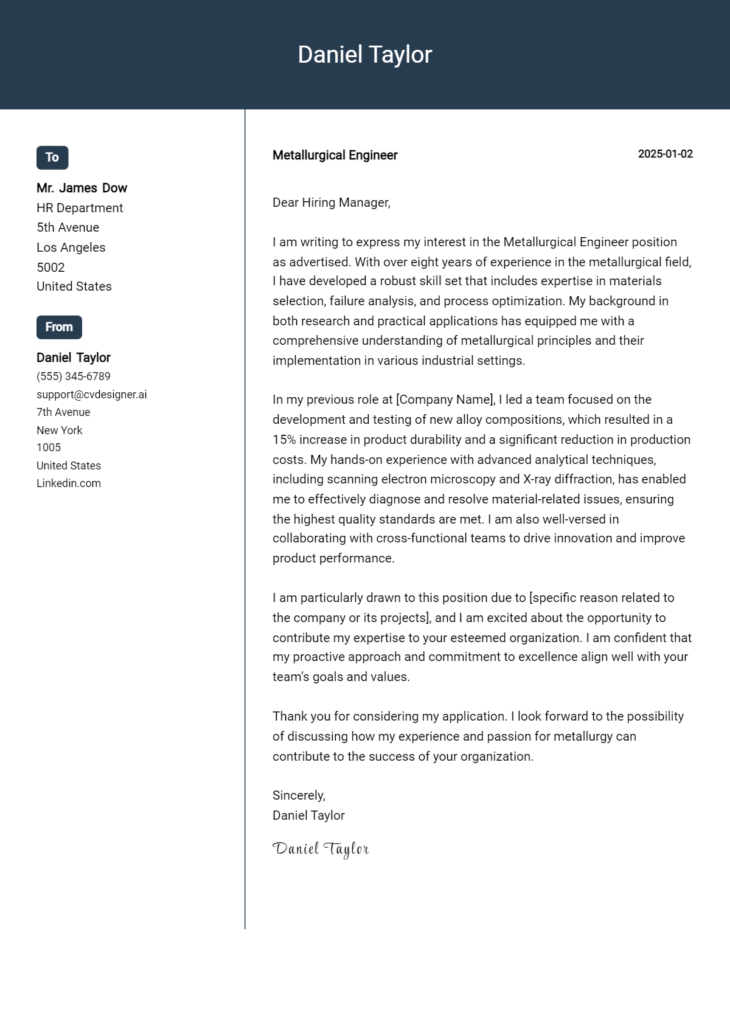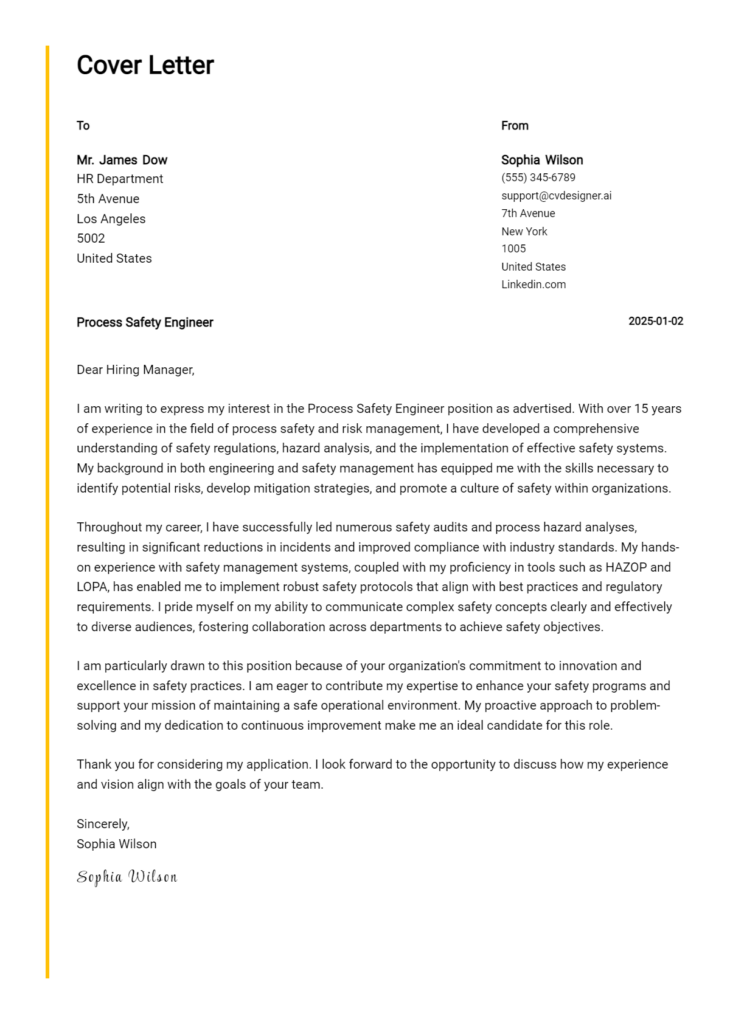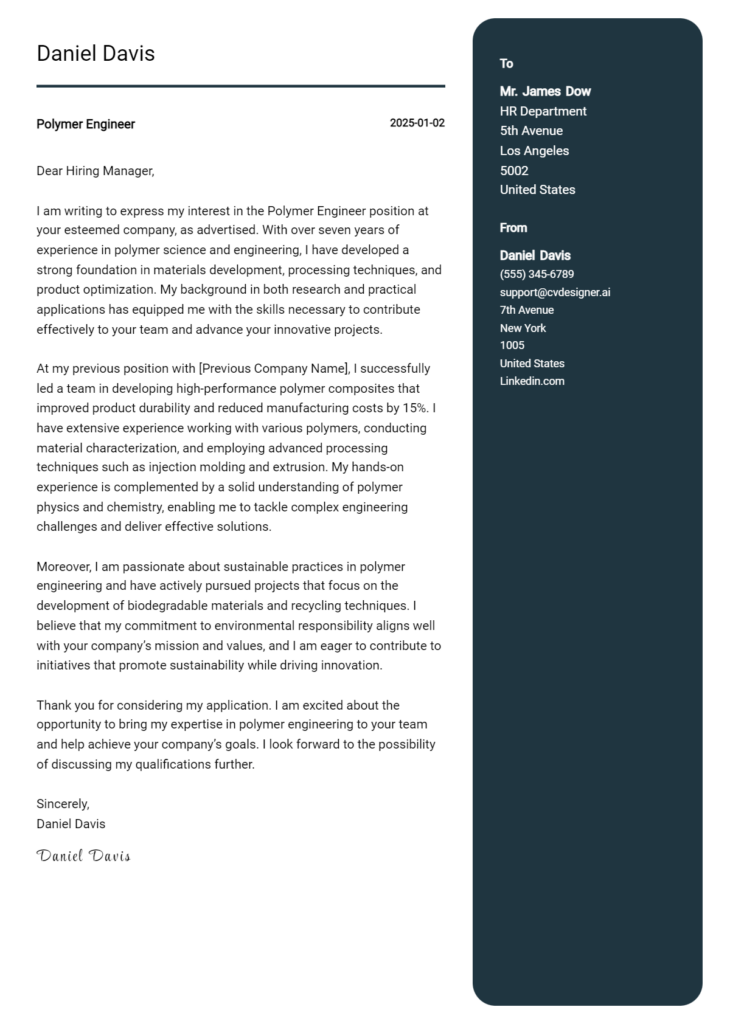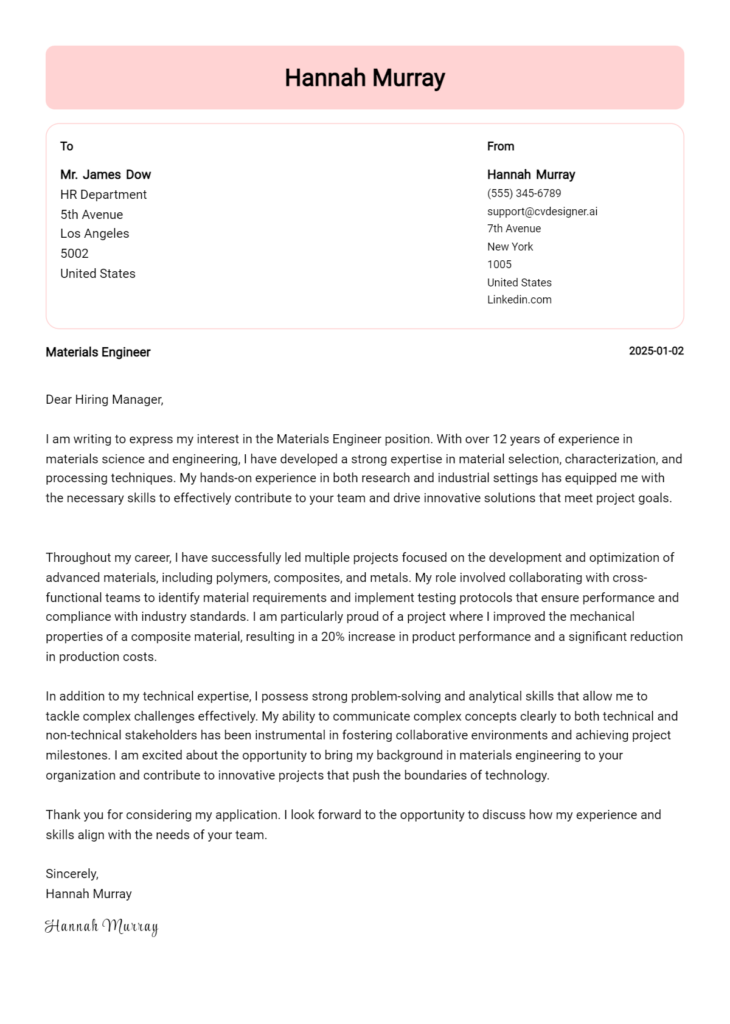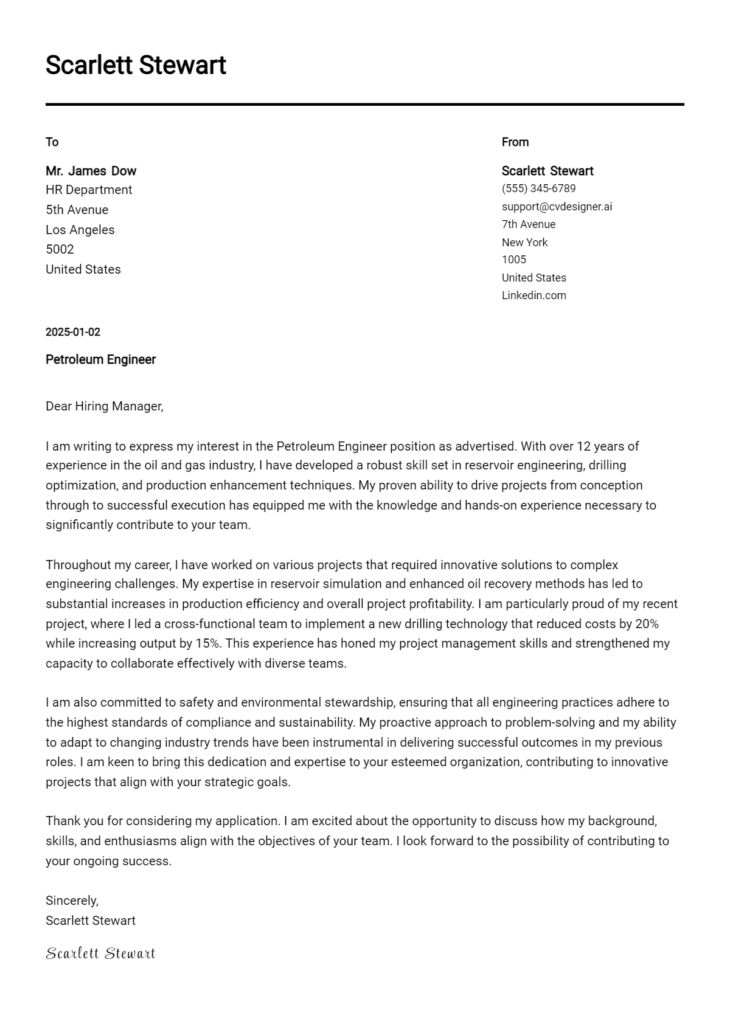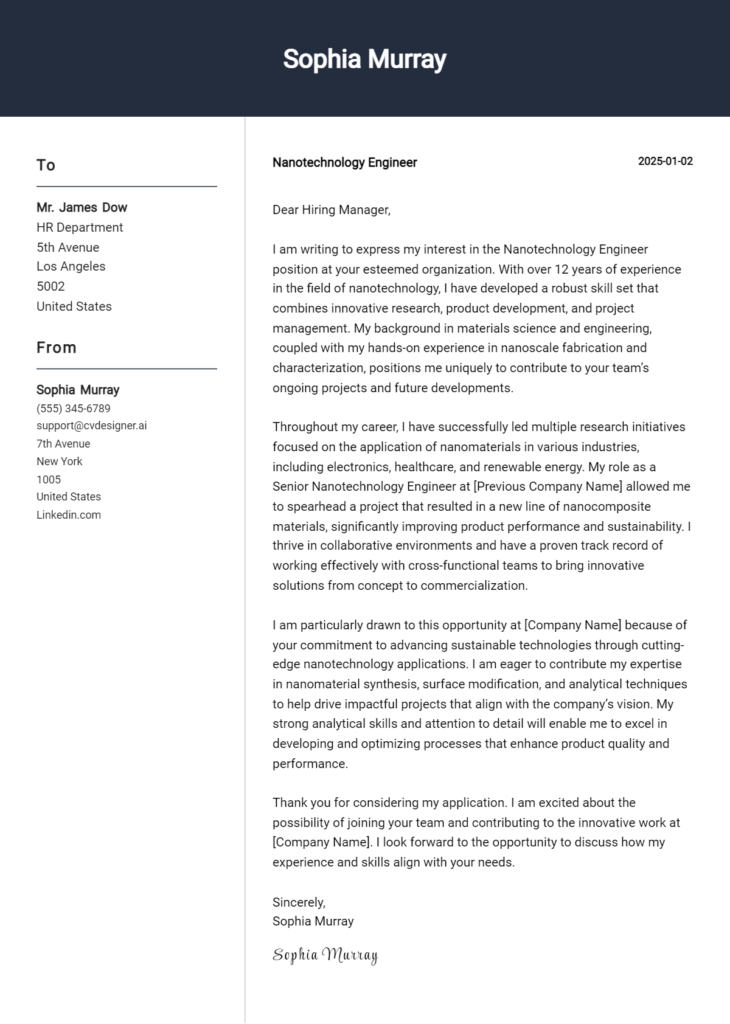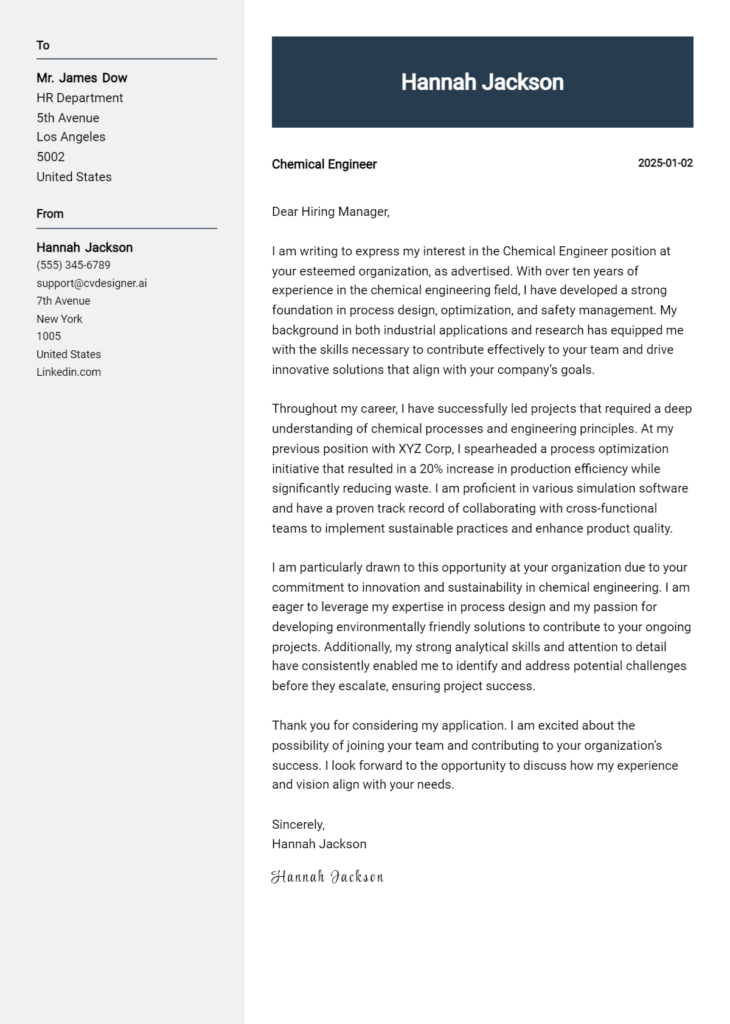Process Engineer Cover Letter Examples
Explore additional Process Engineer cover letter samples and guides and see what works for your level of experience or role.
How to Format a Process Engineer Cover Letter?
Crafting a compelling cover letter for a Process Engineer position is essential to effectively communicate your qualifications and fit for the role. The way you format your cover letter not only showcases your technical skills and experience but also reflects your ability to adhere to structured processes—a critical aspect of engineering. A well-organized cover letter captures the hiring manager's attention and underscores your attention to detail and problem-solving capabilities, which are vital in the engineering field.
In this guide, we will outline the essential components of a professional cover letter, including:
- Cover Letter Header
- Cover Letter Greeting
- Cover Letter Introduction
- Cover Letter Body
- Cover Letter Closing
Each section is crucial in presenting your qualifications and professionalism. Let’s delve into each part and explore how to make your Process Engineer cover letter stand out.
Importance of the Cover Letter Header for a Process Engineer
The header of a cover letter is a crucial component that sets the tone for your application. It provides essential information in a clear and professional manner, allowing the recipient to easily identify who you are and how to contact you. For a Process Engineer, clarity in the header reflects your attention to detail—an essential quality in this role. The header should include your contact information, the date of writing, and the recipient's details, ensuring that all relevant parties can be reached without confusion.
An effective header demonstrates professionalism and gives a positive first impression to potential employers. Below are examples of a strong and weak cover letter header for a Process Engineer.
Strong Example
John Doe 123 Engineering Lane City, State, ZIP johndoe@email.com (123) 456-7890 October 15, 2023 Hiring Manager XYZ Engineering Solutions 456 Industry Road City, State, ZIP
Weak Example
johndoe@email.com 10/15/23 XYZ Engineering
The Importance of the Cover Letter Greeting for a Process Engineer
The greeting of a cover letter is crucial as it sets the tone for the entire message and establishes a connection between you and the hiring manager. A well-crafted greeting demonstrates professionalism and personalization, showing that you have taken the time to address the recipient directly rather than using a generic salutation. This small detail can make a significant difference in how your application is perceived. To avoid generic greetings, it’s beneficial to do some research to find out the name of the hiring manager or recruiter. This effort not only reflects your attention to detail but also your genuine interest in the position.
Here are some examples of strong and weak greetings for a Process Engineer cover letter.
Strong Greeting Example
Dear Ms. Johnson,
Weak Greeting Example
To Whom It May Concern,
Importance of a Well-Crafted Cover Letter Introduction for a Process Engineer
A well-crafted cover letter introduction is essential for a Process Engineer as it serves as the first impression to a hiring manager. This critical opening should not only capture the reader's attention but also convey the candidate's genuine interest in the position. Additionally, it should succinctly highlight key skills or notable achievements relevant to the role, setting the stage for the rest of the letter. A compelling introduction can distinguish a candidate in a competitive job market, while a weak one may lead to missed opportunities.
Strong Example
Dear [Hiring Manager's Name], As a dedicated Process Engineer with over five years of experience in optimizing manufacturing processes, I was thrilled to discover the opening at [Company Name]. My expertise in Lean Six Sigma methodologies and my successful track record of reducing production costs by 20% while improving product quality make me a perfect fit for your team. I am eager to bring my skills in process analysis and continuous improvement to help drive [Company Name]'s commitment to excellence.
Weak Example
To Whom It May Concern, I am writing to apply for the Process Engineer position. I have some experience in engineering and I think this job might be interesting. I hope I can contribute to your company in some way.
Purpose of the Cover Letter Body for a Process Engineer
The cover letter body for a Process Engineer serves as a critical platform for candidates to illustrate their technical expertise, relevant experiences, and the unique value they bring to a potential employer. This section allows applicants to highlight specific projects or accomplishments that demonstrate their ability to optimize processes, improve efficiency, and contribute to the bottom line. By showcasing measurable results, such as cost savings or production improvements, candidates can effectively convey their problem-solving skills and readiness to tackle challenges within the organization.
Strong Example
In my previous role at ABC Manufacturing, I led a project that successfully reduced production downtime by 25% through the implementation of a new scheduling system and streamlined workflows. By collaborating closely with cross-functional teams, I was able to identify bottlenecks and develop targeted solutions that not only enhanced efficiency but also improved overall product quality. My efforts resulted in annual savings of over $150,000, and I am eager to bring this same level of dedication and innovation to the Process Engineer position at your company.
Weak Example
I have worked as a Process Engineer for several years. I have experience with different projects and have done some things to help my previous companies. I think I would be a good fit for your company and would like to work there.
Importance of the Cover Letter Closing for a Process Engineer
The closing paragraph of a cover letter is crucial for a Process Engineer as it provides an opportunity to succinctly summarize qualifications, express enthusiasm for the position, and encourage the employer to take the next step. A strong closing can reinforce the candidate's suitability for the role and leave a lasting impression, while a weak closing may fail to convey genuine interest or prompt further action. Below are examples of both strong and weak closing paragraphs.
Strong Example
Thank you for considering my application for the Process Engineer position. With a solid background in optimizing manufacturing processes and a proven track record of implementing cost-saving initiatives, I am eager to contribute to your team at [Company Name]. I look forward to the opportunity to discuss how my skills align with your needs and would be thrilled to further explore my fit for this role in an interview. Please find my resume attached for further details, and I hope to hear from you soon.
Weak Example
I hope you look at my resume. I think I would be a good fit for the Process Engineer job. Let me know if you want to talk.
These tips will guide candidates in writing an effective cover letter for a Process Engineer position, emphasizing the importance of showcasing technical skills, problem-solving abilities, knowledge of the Software Development Life Cycle (SDLC), teamwork, and a passion for continuous learning. A strong cover letter can set you apart from other candidates by highlighting your unique qualifications and motivation for the role.
Tips for Crafting an Effective Cover Letter for a Process Engineer
Highlight Technical Skills: Clearly outline your technical skills relevant to the position. Mention specific software, tools, or methodologies you are proficient in, such as CAD software, process simulation tools, or Lean Six Sigma principles. Use concrete examples from your past experiences to demonstrate how these skills contributed to successful projects.
Emphasize Problem-Solving Abilities: As a Process Engineer, problem-solving is crucial. Illustrate your analytical thinking by providing examples of challenges you faced in previous roles and the innovative solutions you implemented. This could include streamlining processes, enhancing efficiency, or reducing costs, showcasing your critical thinking in action.
Showcase SDLC Knowledge: If the process engineering role involves aspects of software development or IT, highlight your understanding of the Software Development Life Cycle (SDLC). Describe any experience you've had working in software-driven projects and how your knowledge of SDLC contributes to your ability to collaborate effectively with cross-functional teams.
Demonstrate Teamwork: Process Engineers often work in teams to achieve common goals. Share instances where you collaborated with colleagues, stakeholders, or clients to deliver successful outcomes. Highlight your communication skills and how you contribute to a positive team environment, reinforcing your ability to work well with others.
Express Passion for Continuous Learning: The field of process engineering is ever-evolving, and a commitment to lifelong learning is essential. Discuss any relevant certifications, courses, or workshops you've completed, as well as your enthusiasm for staying updated with industry trends and advancements. This shows your dedication to personal growth and your proactive approach to professional development.
For more tailored guidance, consider using cover letter templates or a cover letter builder to help structure your letter effectively.
Common Mistakes to Avoid in a Process Engineer Cover Letter
Crafting a compelling cover letter is essential for making a strong impression as a Process Engineer. Avoiding common mistakes can significantly enhance your chances of landing an interview. Here are some pitfalls to watch out for:
Generic Greetings: Using a generic salutation like "To Whom It May Concern" can make your cover letter feel impersonal. Instead, research the hiring manager's name to personalize your greeting.
Lack of Specificity: Failing to mention specific skills or experiences relevant to the job can weaken your application. Tailor your cover letter to highlight your expertise in process optimization or project management.
Repeating Your Resume: Your cover letter should complement your resume, not repeat it. Use it as an opportunity to elaborate on key achievements or projects that showcase your qualifications.
Ignoring the Job Description: Not aligning your letter with the job description can lead to missed opportunities. Make sure to address how your skills and experiences directly relate to the requirements outlined in the posting.
Poor Formatting: A cluttered or unprofessional layout can distract from your message. Adhering to a clear cover letter format will help present your information effectively.
Overly Formal Language: While professionalism is essential, using overly complex language can alienate the reader. Aim for a balance of professionalism and conversational tone.
Neglecting to Proofread: Spelling and grammatical errors can undermine your professionalism. Always proofread your letter or ask someone else to review it before submission.
By avoiding these common mistakes and following best practices, you can create a compelling cover letter that stands out. For inspiration, check out various cover letter examples to see how effective letters are structured.
Cover Letter FAQs for Process Engineer
What should I include in my cover letter for a Process Engineer position?
When crafting your cover letter for a Process Engineer role, it's essential to include several key elements. Start with a strong opening that captures the hiring manager's attention, mentioning the specific position you're applying for. Highlight your relevant educational background, such as a degree in chemical, mechanical, or industrial engineering. Discuss your experience with process design, optimization, and any relevant software tools, such as AutoCAD or MATLAB. Provide specific examples of projects where you improved efficiency or reduced costs. Additionally, express your knowledge of industry standards and regulations, emphasizing how you can add value to the company. Finally, convey your enthusiasm for the role and the organization, making it clear why you're a great fit.
How can I demonstrate my technical skills in the cover letter?
To effectively demonstrate your technical skills in a cover letter for a Process Engineer position, incorporate specific examples and metrics. Rather than just stating that you have experience with process modeling, describe a project where you used software like Aspen Plus to optimize a chemical process. Include quantifiable results, such as a percentage increase in efficiency or a decrease in waste. You can also mention any certifications or trainings that validate your technical proficiency, such as Six Sigma or Lean Manufacturing certifications. By providing concrete examples and linking them to the job requirements, you will create a compelling narrative that showcases your abilities and relevance to the position.
Should I tailor my cover letter for each application?
Absolutely! Tailoring your cover letter for each application is crucial in making a positive impression. Employers appreciate candidates who take the time to align their skills and experiences with the specific requirements of the job. Start by carefully reading the job description and identifying key skills and qualifications that the employer is seeking. Then, customize your cover letter to highlight those aspects of your background, emphasizing how your experiences directly relate to the role. This not only demonstrates your genuine interest in the position but also shows that you've done your homework on the company and understand their needs. A tailored cover letter can significantly enhance your chances of landing an interview.
How long should my cover letter be for a Process Engineer role?
A cover letter for a Process Engineer role should ideally be one page long, consisting of three to four concise paragraphs. The length allows you to provide sufficient detail about your qualifications while still being respectful of the hiring manager’s time. Aim for around 250-400 words. Start with a strong introduction that states your interest in the position and summarizes your qualifications. In the body, elaborate on your relevant experience and technical skills, using specific examples that align with the job description. Finally, conclude with a brief summary of why you’re a good fit for the role and a call to action, expressing your eagerness for a potential interview. Keeping your cover letter succinct yet informative is key to making a memorable impression.
Build your Cover Letter in minutes
Use an AI-powered cover letter builder and have your letter done in 5 minutes. Just select your template and our software will guide you through the process.

